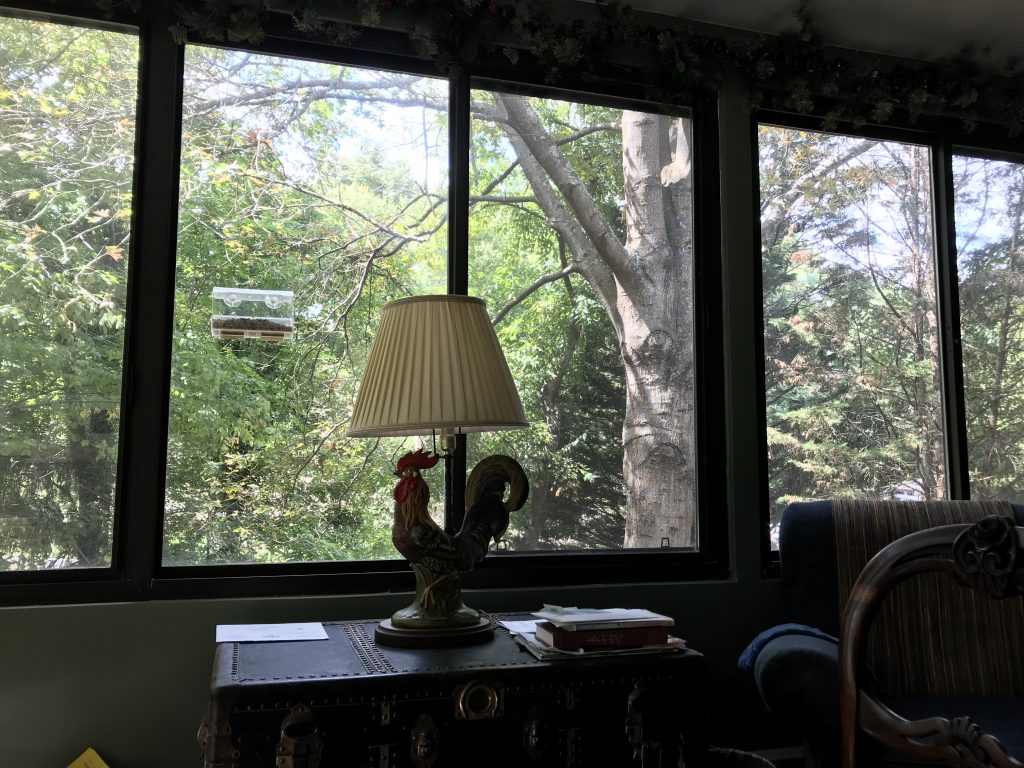September 14, 2019
Diapers or Bible Study: Do I Have to Choose? by Carroll Smith


I love sitting in our sunroom. It has glass windows on two sides. I can see the birds eat from the clear plastic bird feeder we have stuck to our window. I can watch the downy woodpecker as it hangs upside down on a tree branch pecking away. The chickadees and the tufted titmice are a pleasure to watch and so are the cardinals. The blue birds are exquisite. I have discovered that the larger the bird the easier they can see movement inside our sunroom. The small birds carry on with their feeding from the tray whether you move about the room or not, while if one moves a cardinal will fly away. Maybe there is something different about the eyes of a bird the larger the bird. When I look out the window, I can see the North American robins scuttering along the ground. They never come up to the feeder. And, just as much fun to watch are the squirrels. They try so hard to get to the feeder but cannot make the distant from the tree to the window. Hoping to jump from the very thin branches as they edge out as far as they can go, the squirrels soon realise that it will not work. Once they realise that they cannot jump from such a weak branch, they scutter back up the branch to a thicker one. What makes it even harder for them is that our sunroom is on the second floor of the house where we can put a bird feeder that they cannot reach. It makes it more fun for us because it puts us in the second layer of foliage in the trees almost to the canopy.
But wait—should not I be praying or doing a Bible study rather than wasting time watching the animals, the budding of the trees and more. Just think of how many people I could pray for if I spent that time praying. I suppose I should be ashamed that I spent time watching God’s creation and not being careful enough with my time. If I were smarter, more efficient, I could use my time more wisely and do greater things for God. I am so deficient and never enough. I should use my time more wisely and make sure that I do not enjoy God’s world because it is fallen, sinful, harmful and I need to escape from it into a more productive prayer life. I should be praying, right? Or, maybe there is a view about this that I have not considered.
Quite a number of years ago I read a book by Ranald Macaulay (Susan Schaeffer Macaulay’s husband) and Jerome Barrs entitled Being Human: The Nature of Spiritual Experience. It was an eye opening book for me and for my wife, Andra. I would encourage you to read it. It was first published, I think, in the 70s but is just as relevant today as it was then. And maybe even more so today especially in the world of education where there are some interesting philosophies or lack of philosophies behind the methods we use.
Macaulay and Barrs’ book discussed the concept of dualism and introduced me to ideas that revolutionised my way of thinking about what it means to be a Christian here on this planet where God placed us—now. It reminds me of a quote Andra found online supposedly by Edith Schaeffer, “We foolish mortals sometimes live through years not realising how short life is, and that TODAY is your life.” Why is this an important topic? Are we not to be working towards getting to heaven and ignoring the uselessness of this present world or the here and now. Is not religious activity enough? If we take care of the religious education of our children, is not that sufficient? Can we not learn everything we need to know from the Bible? These are questions that I hear people struggle with everyday. How should we think about these things? I hope to take a few steps towards answering these questions as we proceed over the next several weeks discussing this topic.
But before I move on there is one thing I want to say. While I value highly Mason’s work—any work, ideas, and behaviours that we discuss and come to believe in need to be grounded in Scripture not in Mason. If we ground them in Mason we walk very close to deifying Mason and we certainly do not want to do that. So what we believe from Charlotte Mason should be grounded in Scripture not the other way around. I write this because I believe that Mason developed about the most non-dualistic curriculum and educational principles that I have ever come across. Since she was a human being, I am sure she made mistakes, but her views on education clearly ring free of Platonic thought, a term I will mention later in these posts.
Why this topic? I believe that these ideas have had a huge affect on education throughout time, and especially now. I believe Mason has provided us with an educational paradigm that avoids dualism. But before we dig into why this is true, let’s consider a definition of dualism.
Dualism is the idea of dividing a concept or idea into two opposing or contrasting elements. For example, good and evil, humankind and nature, sacred and secular. Macaulay and Barrs discuss in their book specifically, the dualism of sacred versus secular. This series of blog posts will concentrate on the affects of dualism in education. But to help you have a clear picture of dualism, let me use my own experience growing up to share with you as an example. In the next post, I share my experience and dig a little deeper into this topic.

